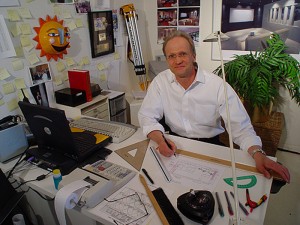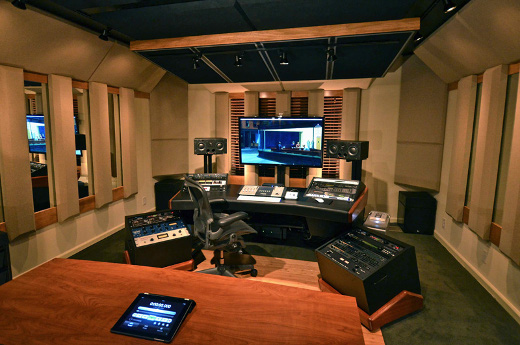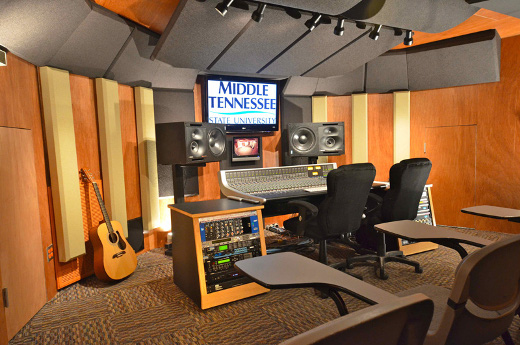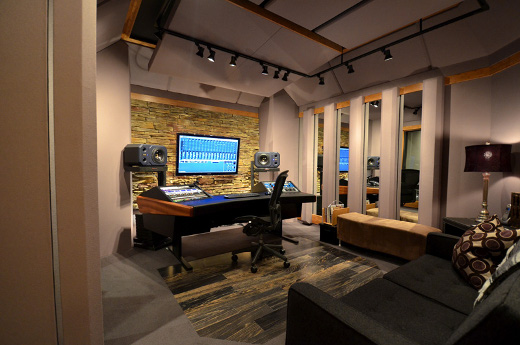Audio Solution Spotlight: MixRoom Monitoring Environment by Carl Tatz
Some audio solutions are simple to get your head around. Others, you just have to get your ears into to fully understand.
MixRoom, the monitoring environment concept from Nashville-based studio designer Carl Tatz, falls into the latter category. Created to provide mixers with a million-dollar listening environment for a fraction of the cost, MixRoom has already taken off in a big way in Music City and its environs, and word is starting to spread wider about a system with a transformative effect on critical listening.
Accessible Acoustics
A turnkey solution for converting a space into a pro studio environment, including bedrooms and living rooms, MixRoom is a triple play of elements. It starts with the Carl Tatz Design (CTD) Phantom Focus system, which is a combination of proprietary protocols, hardware and software, developed by Tatz to optimize monitor systems. The next layer that gets added is the Carl Tatz Signature Series by Auralex family of rigid fiberglass control room acoustic modules.
The final component is Tatz himself, who personally calculates, designs and tunes each room with the experience he’s gained from decades of creating studios such as the famed Recording Arts, The Blue Grotto, Willisoundz II, Yes Master, Red Decibel East, and many more. Armed with his aural mojo, Tatz himself is the glue that makes each MixRoom come together in its final form.
“I think I’m somewhat of a rogue,” Tatz admits from his Nashville workshop. “I’ve broken a lot of acoustic rules, and ignored a bunch of myths about acoustics and speakers. One part of what makes an engineer great is that they know what they want to hear – they’ll have a bunch of tracks in front of them, they know what they want it to sound like, and they get there. That’s like me: I have a vision of what I want from a studio, and I don’t leave until it’s where I want it to be.
“If I’m not moved emotionally during the tuning process, then I don’t have it yet and I continue until I’m satisfied that it’s the best it can be,” Tatz continues. “When you play a cut that you love, and you’ve never heard it like that in your life, the imaging and the accuracy can literally make people cry. A listening experience that’s that powerful, but still translates 100% to the outside world – is the goal of the whole thing.”
Mixing In
For platinum mix engineer Bob Bullock (Shania Twain, Reba McEntire, George Strait), MixRoom was the preferred method to transform an unused family room in his Nashville home into a world-class mixing environment.
“When I started working in recording studios in the 1970’s, everything you heard on the radio was produced at a recording studio,” Bullock recalls. “Now, because everyone is recording at home on a computer, things are a lot more homogenized. To be considered a craftsman, now more than ever it’s critical for me to have an accurate environment, because it’s the only way to stand out.”
Long familiar with the sound of many of Tatz’ studios, Bullock called on the studio designer to apply MixRoom to his 14’ x 19’ space, equipped with Dynaudio M1 Professional monitors, and a Bryston 4B amp. Tatz came to Bullock’s space, analyzed the room layout and calculated axial modes, installed the Signature Series modules, and then implemented the PhantomFocus System once everything was in place.
The result for Bullock is a world-class room, created on a real-world budget, which is the MixRoom concept. “Whether the tracks I’m mixing are great quality or something less, I can hear what I’ve got to work with and make accurate decisions,” says Bullock. “The key is the imaging we’ve achieved here. I’m often working on songs with 40 or 50 audio tracks – a big part of mixing is you want to be able to hear all those parts simultaneously. If you move a guitar 30 degrees to the left, you want to know where that is. Or if something is bright on the right, I want something to complement it on the other side. I have the confidence that what I do here will translate elsewhere.”
Educational Applications
One of the cornerstone music and audio programs in the country resides at Middle Tennessee State University (MTSU) in Murfreesboro. Out of the six control rooms there, four had proven extremely popular among students and faculty. But the smaller Studios D & E, shoehorned as they were into former dorm rooms, were rarely at the top of anyone’s list for finishing a mix.
MTSU made the decision to upgrade the rooms at several levels in 2012, endowing them with SSL AWS consoles, API mic pres and compressors, and a MixRoom makeover to complement the existing Genelec 1038 monitors.
“Studios D&E went from our worst control rooms for monitoring and mixing to two of our best,” says Bill Crabtree, Interim Chair, Associate Professor, Department of Recording Industry, MTSU. “Carl’s MixRoom concept corrected the control rooms’ frequency response anomalies due to room modes, reflections and boundary effects. A large part of that was handled through the PhantomFocus System, some of it was custom-built surface treatments, and some of it came from his Signature Series by Auralex modules. All told, the process of redoing the rooms took two to three weeks.”
While some might have seen the MixRoom install as overkill for an educational facility, Crabtree views it differently. “Our feeling is that if students don’t develop a sense of the ideal, then they don’t know where they stand,” he says. “We want to give them the best tools we can, so that they can discriminate good-sounding monitors from ones that aren’t. Studios D and E went from rooms everyone avoided to being in much higher demand, so the result for us was a gain in available studio time.”
Sweetening Songwriter Suites
Another professional audio demographic checking the solution are songwriters and producers. The GRAMMY-winning songwriter Monty Powell (Keith Urban, Rascal Flatts, Lady Antebellum) and jazz artist Anna Wilson needed a bedroom in their townhouse to take on another identity.
Like many prolific songwriters, Powell does his tracking at facilities with large live rooms and analog consoles, then brings the tracks back to his personal studio for mixing. By employing MixRoom in his upstairs bedroom, Powell was able to get far more out of his classic Tannoy 800A monitors than he’d heard before.
“Carl has found a way to bring the cost of having a professional room down so that it works in today’s environment,” says Powell. “Part of the excitement is that top-level audio is actually possible now in a personal studio: The technology is affordable to a lot of people. I think the MixRoom is one of the most cost effective ways to fix what’s wrong with most people’s processes –because what’s wrong most of the time is that they’re in a mediocre acoustic environment.”
For Powell, the most evident gains have come from a much larger critical listening area that’s useful beyond the sweet spot, as well as vastly sharpened imaging. With songwriting and production clients typically on a short schedule, the increase in monitoring confidence ushers in a faster workflow.
“You start doing better work earlier in the process,” he explains. “That’s one of the places where we lose time and money, is mixing stuff that should have been great the first time. When you’ve got such a critical place to listen, it makes you want to make sure that you’re doing a better job early on in the process. So when we bring tracks back from the recording studio and push them up on the faders here, we know we absolutely got what we were intending to get.”
Art + Science of Sound
For Carl Tatz, MixRoom has become an efficient way to connect what he calls “the acoustic trinity”: the speaker, the listener, and the room. While up-to-the-minute technology is essential to making a MixRoom happen, the part that pulls it all together is an intangible: the uniquely human element needed to execute any work of art, musical or otherwise.
“I could order the speakers and the processor, but the fine tuning of it is Carl himself, working with the system in a way that’s a little bit of science and a little bit of feel,” Bob Bullock reflects. “I hope people would say the same thing about my work: They could build the same studio, have the same equipment and move the same faders, but there are things that only I can bring to the mix.”
— David Weiss











trayj57
September 6, 2013 at 4:22 pm (11 years ago)Great work Carl I met you once at the Nashville Mix when you were on the panel talking about studio design & treatments you gave us some great advice! Will be building a new studio next year will be contacting you! http://www.backwoodsrecordingstudio.com
Carl Tatz
September 6, 2013 at 8:03 pm (11 years ago)Hi Tony,
Thank you. I’ll be looking forward to your call!
Carl